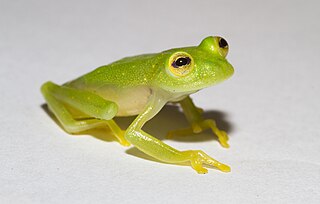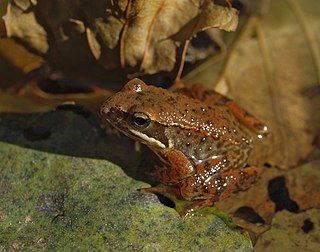Cochranella vozmedianoi is a species of frog in the family Centrolenidae, endemic to the Cerro El Humo, in the Paria Peninsula in northern Venezuela.

Hyalinobatrachium vireovittatum is a species of frog in the family Centrolenidae. It is found in scattered localities in Costa Rica and west-central Panama. It has, however, been suggested that most populations actually represent Hyalinobatrachium talamancae, with Hyalinobatrachium vireovittatum restricted to its type locality in the San Isidro de El General district.
Hyloxalus edwardsi is a species of frogs in the family Dendrobatidae. It is endemic to the Cordillera Oriental in the Cundinamarca Department, Colombia. It is named after Stephen R. Edwards from the University of Kansas Natural History Museum, a colleague of John D. Lynch who described this species in 1982.
Aromobates duranti is a species of frog in the family Aromobatidae. It is endemic to Venezuela where it is known from near La Culata in the Cordillera de Mérida. Its natural habitats are clear, fast-flowing streams in Andean cloud forest and sub-páramo shrubland. The male protects the eggs that are laid on land. After hatching, the male carries the tadpoles on his back to water where they develop further.
Aromobates haydeeae is a species of frog in the family Aromobatidae. It is endemic to Mérida and Táchira states in western Venezuela. Its natural habitats are clear, fast-flowing streams in Andean cloud forest and the puddles alongside the streams. They may sometimes hide inside introduced Pennisetum clandestinum grasses. The male protects the eggs that are laid on land. After hatching, the male carries the tadpoles on his back to water where they develop further.
Aromobates orostoma is a species of frog in the family Aromobatidae. It is endemic to Venezuela where it is only known from near its type locality, Boca de Monte in the Táchira state. Its natural habitats are mountain streams in cloud forest. The male protects the eggs that are laid on land. After hatching, the male carries the tadpoles on its back to water where they develop further.

Plectrohyla sagorum is a species of frog in the family Hylidae. It is found in the Sierra Madre de Chiapas from Chiapas (Mexico) to southwestern Guatemala, with a single record from northwestern El Salvador. Its natural habitats are cloud forests at elevations of 1,000–2,050 m (3,280–6,730 ft) above sea level. Breeding takes place in streams. It is very rare in Mexico and El Salvador but abundant at two Guatemalan sites. It is threatened by habitat loss. Chytridiomycosis might also be a threat.

Ptychohyla salvadorensis is a species of frog in the family Hylidae found in El Salvador, Guatemala, and Honduras. Its natural habitats are subtropical or tropical moist montane forests, rivers, pastureland, and heavily degraded former forests. It is threatened by habitat loss.

Leptopelis macrotis, sometimes called the big-eyed forest tree frog, is a species of frog in the family Arthroleptidae. It is found in the rainforests of Sierra Leone, southern Guinea, Liberia, Ivory Coast, and southern Ghana. Notice that similar common name "big-eyed tree frog" is sometimes used for Leptopelis vermiculatus from Tanzania and for Litoria exophthalmia from New Guinea.
The palm forest tree frog, Leptopelis palmatus, is a species of frog in the family Arthroleptidae endemic to the Príncipe island, in São Tomé and Príncipe. Red tree frog Leptopelis rufus from the African mainland was for a long time included in this species, but is now considered a distinct species.
Alcalus baluensis is a species of frog in the family Ceratobatrachidae. It is endemic to northern and western Borneo and found in Brunei, Indonesia, and Malaysia. Its common name is Balu eastern frog or dwarf mountain frog. It was placed in Dicroglossidae before being transferred to Ceratobatrachidae in 2015.
Amolops chunganensis is a species of frog in the family Ranidae. Its type locality, Kuatun village in Wuyishan, Fujian. It is endemic to central, southern and eastern China where it has a wide but scattered distribution ; records from Vietnam probably refer to Amolops mengyangensis.
Nanorana unculuanus is a species of frog in the family Dicroglossidae. It is endemic to central and southern Yunnan, China, although it is expected to have wider distribution than currently known, possibly extending into Vietnam. Its natural habitats are fast-flowing hill streams and riparian habitats in forests and grasslands, but also man-made habitats like roadside drainage ditches and ponds. It is a rare and secretive species that appears to be declining. It is currently threatened by collection for food and also by habitat loss.

Quasipaa exilispinosa is a species of frog in the family Dicroglossidae. It is known under many common names, including Hong Kong spiny frog, common spiny frog, lesser spiny frog, little spiny frog, and Hong Kong paa frog. It has a patchy distribution in southern China including Hong Kong. Its natural habitats are subtropical hill streams in forests or shrublands, and sometimes also seepages, stream-fed marshes, and forests. It is threatened by over-collecting for human consumption and by habitat loss.
Odorrana hejiangensis is a species of frog in the family Ranidae that is endemic to China. It is found in the Yangtze River Valley of southern Chongqing and northern Guizhou, with an isolated record in western Guangxi. Its name refers to the type locality, Hejiang County in northern Sichuan. Its natural habitats are shaded hill streams and the surrounding riparian forests. Its status is insufficiently known.

The Iberian frog, also known as Iberian stream frog, is a species of frog in the family Ranidae found in Portugal and Spain. Its natural habitats are rivers, mountain streams and swamps. It is threatened by habitat loss, introduced species, climate change, water contamination, and increased ultraviolet radiation.
Odorrana kuangwuensis is a species of frog in the family Ranidae that is endemic to China. It is found in northeastern Sichuan and northwestern Hubei. Its name refers to the type locality, Mount Guangwu in Nanjiang County, northern Sichuan.
Odorrana lungshengensis is a species of frogs in the family Ranidae that is endemic to China. It is found in northeastern Guangxi, southwestern Hunan, and eastern Guizhou. Its natural habitats are hill streams in broad-leaf forests. It is becoming rare due to habitat loss.
Sylvirana maosonensis is a species of frog in the family Ranidae. It is found in the mountains of central and northeastern in Vietnam, Annamite Range in central Laos, and southern Guanxi, China. Its common name is Mao-Son frog or Maoson frog, after its type locality in Vietnam. It inhabits evergreen forests at elevations of 200–1,500 m (660–4,920 ft) above sea level. Individuals are typically found near streams on banks, leaf litter, and low in vegetation. Reproduction takes place in streams, ponds, and ditches. It is a locally common frog. Although International Union for Conservation of Nature (IUCN) does not considered it threatened as a species, habitat loss and degradation are threats.
Celsiella is a small genus of glass frogs endemic to Venezuela. It was established in 2009 and named in honour of Josefa Celsa Señaris, nicknamed "Celsi", a Venezuelan herpetologist who had worked with glass frogs.






